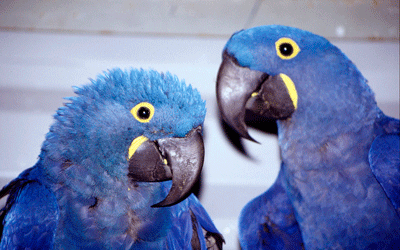 by Jim Hayward
by Jim Hayward
Original homeland
Central Brazil, eastern Bolivia and north east Paraguay.
Natural habitat:
Their natural habitat is forest, swamp and palm groves where they are usually seen in small groups.
Status in the wild:
Endangered and disappearing from many areas of its former distribution.
Status in aviculture:
Rare but maintained by a few skilled breeders; one single dedicated breeder in USA has worked up from a couple of pairs to a stock of over forty, but this has taken many years. Breeders not CITES registered must apply for DOE licences to advertise and sell each individual bird.
Level of keeper’s experience:
Experience in the breeding and management of any of the larger commonly kept macaws is advised before entertaining any ideas on keeping this species.
Hardiness:
Not as hardy as the Ara Macaws; some breeders in the colder parts of the USA say that they have to keep their birds in inside accommodation most of the year.
Type of accommodation:
Examples of breeding flights range from 10ft long by 7ft high and 7ft wide where kept inside, and 30ft long by 20ft wide and 22ft high where kept outside! Aviaries are usually made with steel framework covered heaviest duty welded mesh often covered with chain link as an extra precaution against escape.
Type of diet:
In the wild, fruits, seeds and especially palm nuts form the main part of their diet. In aviculture, large nuts (walnuts, Brazil nuts, peanuts), sunflower, coconut, ZuPreem biscuits (in USA), all kinds of fruit and vegetables, wholemeal bread, egg food, with corn-on-the-cob fed in increased quantity when the birds are nesting.
Sexing:
The sexes are alike therefore surgical sexing or DNA sexing is usually resorted to.
Nesting season:
In the wild, from July to December; in aviculture, extremely variable but usually commencing in late spring, though second nests can occur well into winter.
Type of nest:
Metal drums (most often set horizontally) are used in the USA where the greatest success has been achieved with this species, with pine wood chips and willow sticks being most frequently used as nesting material. The obvious problems with metal nests are their lack of insulation, but wooden nests are so easily destroyed.
Usual number of eggs:
Most often two, sometimes one, very rarely three, with at least one recorded nest of four eggs.
Incubation period:
29 to 31 days.
Usual number of young:
One, with a second frequently lost unless removed for hand rearing.
Fledging age:
Ninety days, with a long weaning period; one breeder often has to continue feeding even parent reared birds by hand at least once a day up until five months old.
Usual number of clutches:
Birds in outside accommodation seem to produce only one nest per year, while those kept under artificial conditions are frequently double brooded.
Nesting habits:
It is said that they nest in the crowns of palms, hollow trees and crevices in cliffs, but little seems to be known of their nesting habits in the wild state.
Special considerations:
This is the largest of all parrots; its formidable jaws can exert such pressure that Brazil nuts are cracked with ease. Certainly its loud voice, size, and ability for destructiveness make it an unsuitable subject for many bird keepers, and its price of several thousand pounds per bird put it way out of the scope of most.
Noise factor:
The voice of a Hyacinthine can be like a rumbling growl or almost like the deep bark of a large dog.
Availability:
Rarely offered for sale in Britain.
